In your garden, purple blooming perennial plants produce lovely hues of lilac, purple, blue, and lavender. Purple perennial blooms come in a variety of sizes, from huge phlox blossoms to tiny violet petals on irises. Being a powerful technique to attract pollinating insects, the various purple hues attract bees and butterflies.
Low-growing creeping plants that help to provide good ground cover are some of the purple perennials available. Larger shrubs or bushes with purple, mauve, and lilac clusters of flowers are also popular among flowering perennials. Purple blooms that bloom on the end of lengthy stems are seen on several tall perennials.
There are purple perennial flowers that can meet your landscaping demands, whatever they may be. The most common purple flowering perennials are discussed in this article, including qualities, features, and characteristics.
What Are Perennial Plants?
Annual plants survive one growing season and then die, whereas perennial plants survive more than two years. Throughout the spring and summer, flowering perennials develop and bloom, dying back during the winter before returning in the spring. Some flowering perennials live for just a few years, whereas others live for much longer.
Do Perennial Plants Come Back Year After Year?
Not every perennial will return each year. Some perennials are difficult to grow and perish during the harsh winter. They are classified as annuals since they only grow for one year. Tender perennials are another name for them. Year after year, certain perennial plants may reappear. They can handle the harsh cold of winter and are hardy perennials. After a harsh winter, they’ll keep returning.
Some perennial plants only bloom once in their second year, and then die. After two or three years, they will need to be replaced in this scenario. After several years, more long-lived perennial plants will require replacing, due to the decline in their vibrant growth.
Purple Perennial Flowers (With Pictures and Names)
Iris

The Iris flower is quite popular and ubiquitous. Iris is a bulbous perennial plant with numerous cultivars that produce lovely purple blooms. Select the ‘winter iris’ (Iris histrioides) or the ‘netted iris’ (Iris reticulata) if you’re after brilliant blue or purple blooming irises. Several varieties of irises, on the other hand, have been bred to bloom in purple hues.
Iris are one of the first bloomers in the spring, and they’re a fantastic option for decorating your garden with incredibly beautiful purple flowers. Around the end of January or the beginning of February, their delicate deep purple spring flowers bloom.
Purple flowering irises are tough perennial plants that can survive the winter, as are other types of iris. Irises should be planted in well-drained soil and receive at least a half day of full sun to thrive. Irises are one of the best flowers for adding color to mixed flower beds. Iris flowers are best planted at the rear of a flower bed or in a row as a boundary to define a landscaped area since they are tall perennial blooms.
Garden Phlox
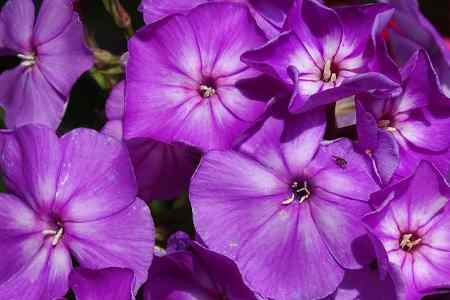
The Garden phlox (botanical name: Phlox paniculata) is a big bushy blooming perennial shrub with several stunning purple cultivars. ‘Grenadine Dream,’ ‘Violet Flame,’ ‘Peacock Neon Purple,’ and ‘Purple Eye Flame’ are some of the purple phlox cultivars that bloom in the summer.
These purple, white, pink, and red blossoms decorate this perennial from summer to fall. Deadhead the plant after it blooms in the autumn to encourage more flowers to bloom. In zones 4 to 8, garden phlox are hardy flowering perennials that prefer bright sun. Along walkways and borders, plant garden phlox in the background of mixed flower beds.
Purple Heart Tradescantia

The Purple Heart (Tradescantia pallida) is a purple perennial with plum-colored leaves and white flowers that is renowned for its purple foliage and white flowers. At the front of flower beds and borders, or in a hanging basket, this flowering purple perennial is a low-growing trailing plant that makes a nice bedding plant.
The light-purple petals of the Purple Heart are not particularly prominent, even though it blooms in the summer. Tradescantia varieties with plum-colored leaves are usually planted by gardeners to contrast with other green plants.
Since it is a fragile perennial, you must live in a temperate zone to cultivate this widespread purple blooming plant outside. This gorgeous purple stem trailing plant can also be grown indoors in pots as a flowering indoor plant. Partial shade is ideal for Purple Heart Tradescantia. The purple color is brought out by indirect sunlight, but it should be protected from strong midday or summer light.
Clustered Bellflower

The clustered bellflower (Campanula glomerata) is a good option if you’re looking for a tall perennial with purple summer flowers. This purple bell-shaped blossom blooms clusters of 23″ (58 cm) and grows to about 23″ (58 cm). A number of dark purple blooms, about 1″ (3 cm) in size, may be held by one stem. The clustered bellflower can withstand partial shade and thrives in full sun.
In the summer, some bellflowers produce purple blooms of a different kind. Rampion bellflower (Campanula rapunculus) and harebell (Campanula rotundifolia) are two cultivars that feature star-shaped light mauve flowers. Clustered bellflowers may be put in rock gardens or at the rear of a perennial border or flower bed and require full sun.
Geranium

Geranium is a tough purple perennial that thrives in full sun. Purple blooms bloom in the spring and remain throughout the summer in some geranium types. The geraniums ‘Rozanne’ and the geraniums ‘Johnson’s Blue’ are two types of flowering purple perennials. The delicate blue/purple petals of both cultivars are deep.
Other types of geraniums produce white, pink, or blue blooms in addition to purple summer blossoms. Since they have lovely leaves and little colorful blooms, planting winter-hardy geranium perennials is a nice landscaping choice. Some geranium cultivars have a 2 ft. (60 cm) height and a similar spread.
Plant geraniums in sunny spots of your garden to give your garden purple flowers throughout the spring and summer. These are popular garden bedding plants, as well as ground cover plants.
Salvia (Sage)

Salvia is a purple flowering plant that thrives in warm, sunny areas and produces beautiful small flowers all summer. In hot, sunny places, this easy care purple perennial plant thrives. The upright flowering stems feature needle-like leaves with tiny flowers on them and grow vertically. Some varieties of salvia produce blue, red, or white flowers in addition to purple.
Many grow salvia (Salvia officinalis) for its delicious taste, in addition to producing beautiful purple flowers every year. In Mediterranean, British, and American cuisine, sage (salvia) is a common herb. For its medicinal qualities, you may also utilize sage. Salvia plants come in a variety of heights, from 18 inches (45 cm) to 5 feet (1.5 meters). Tall varieties may be cultivated in planters as well as at the rear of flower beds and gardens.
Veronica

Veronica (Veronica spicata) is a lovely perennial with long stems that bear purple flowers at the end of each stem. Purple Veronica cultivars include ‘Royal Candles’ and Veronica ‘Purple Explosion,’ which have long purple stems. The flowers might appear as dark purple spikes or clusters of tiny purple blooms, depending on the kind of plant.
This low-maintenance plant is hardy to USDA zone 3 and blooms year after year. Plant this perennial in full sun behind other smaller bedding plants to fully appreciate the stunning purple blooms.
Anemone

Anemone is a genus of plants that include perennial varieties with purple spring blooms, such as Anemone blanda. The purple anemone (Anemone blanda) has purple-blue petals and a bright yellow heart, and it is the most prevalent form. In full sun to partial shade, it thrives in zones 5 to 8.
The broad-leaved anemone (Anemone hortensis) produces light violet star-shaped blooms and is another purple spring flowering option. Plant Anemone in full sun to partial shady spots of your garden to ensure that this purple perennial blooms early in the spring. Plants in the front of a flower bed or border in rich, moist soil.
Aster

Aster plants seem to be a favorite in sunny gardens, as they are perennial blooming plants with lovely purple blossoms. Bees, butterflies, and other pollinators are drawn to aster flowers because of their purple color. The daisy-shaped blooms are purple or lilac and grow on tall stems that can reach 8 feet (2.4 meters) in height.
Most perennial varieties, on the other hand, are shorter. The petals of the light purple are also lovely. The flower head of some aster cultivars has a puffy appearance due to the multilayered dark purple petals.
In late summer or the fall, if you have asters in your garden, you can expect purple blooms. As a result, asters are one of the newest purple blooming plants to bloom. The majority of asters kinds flourish in full sunlight, although others may do with partial shade. USDA hardiness zones vary from 4 to 8 depending on the variety. At the back of flower beds and borders, plant tall asters.
Chrysanthemum

Chrysanthemum is a purple perennial that blooms late in the summer and comes in several cultivars. When they bloom in July and August, these plants create bursts of purple, lilac, and mauve flowers. Chrysanthemums come in a variety of colors and are flowering plants.
‘Lynn,’ with two-tone lavender blooms and a purple center, ‘Stargazer,’ with dark lavender petals, and ‘Barbara,’ with purple pompons are some types of purple-flowered mums. They grow to be between 1.5 and 3 feet (45 and 90 cm) tall, with a spread of roughly 3 feet (90 cm), depending on the variety of chrysanthemum.
The sheer number of flowers from each plant is one reason why chrysanthemum perennials are so popular. You’ll have exquisite purples, reds, yellows, and whites brightening up your yard if you plant a number of varieties. Chrysanthemums are suited for growing in USDA hardiness zones 5-9 and prefer full sun. Mixed flower beds, borders, and standalone specimens are all options for growing them.
Blue False Indigo
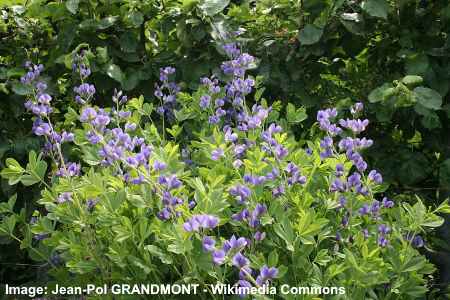
The Blue Indigo (Baptisia australis) is a lovely bushy perennial that blooms early in the spring and belongs to the category of early bloomers. Longer stems up to 5 feet (1.5 meters) tall and spreading between 2 feet (0.6 meter) may be found on this shrub-like plant. and 3 feet (0.6 – 1 meter). Little ovate leaves cover the stems, providing excellent ground coverage.
Little pea-sized dark purple or blue blooms grow on lengthy stems in the early spring and summer when Blue False Indigo blossoms. False Indigo may be taller by 1 to 2 feet (30 to 60 cm) thanks to the purple blooming stems. With well-drained soil and plenty of sunlight, you can plant these purple perennials. Three to ten USDA hardiness zones exist.
Clematis ‘Etoile Violette’
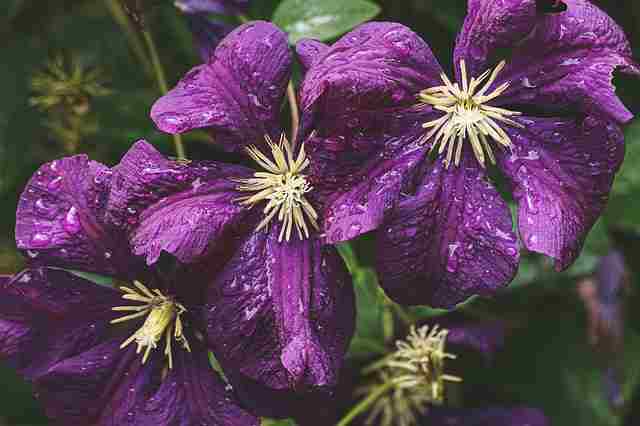
If you want a perennial climbing plant with dark purple or violet flowers, Clematis cultivar ‘Etoile Violette’ is a good choice. The petals of the Etoile Violette are 4″ (10 cm) across and are fairly wide. These purple blooms, which bloom in the mid- to late-summer, are a fantastic addition to a trellis, arbor, wall, or fence.
The purple climber vine prefers moist, well-drained soil and can grow in full sun or partial shade. The fact that it grows quickly every year is one of the reasons to add this purple flowering vine. The purple-flowered clematis plant, which may grow up to 15 feet (4 meters) long, produces an abundance of purple blooms. In zones 4–9, clematis are hardy perennials.
Garden Heliotrope

The garden heliotrope is a perennial flowering shrub that bears clusters of vivid tiny purple flowers. The delicate vanilla fragrance of these clustered violet-purple flowers is one of their most interesting features. While smaller varieties for growing in containers are available, these evergreen shrubs may grow up to 3.9 ft (1.2 m) tall. Large leaves cover the blooming shrub, which bears purple blossoms and provides good ground cover. As a border or feature in a flower bed, this flowering perennial shrub thrives.
Summer flower clusters can reach up to 4 inches (10 cm) in diameter and are lovely purple. Largeer purple flowerheads are seen in certain cultivars. The ‘Marine, for example, features huge purple clusters that are 6 inches (15 cm) in diameter. Heliotrope is a tender perennial that shouldn’t be confused with the herb valerian, which is sometimes known as “garden heliotrope.”
Crocus
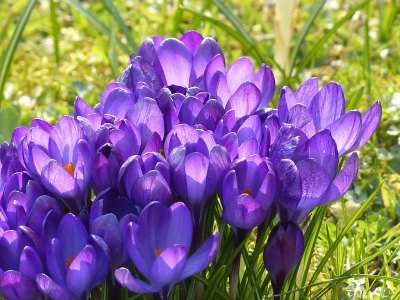
Crocus is a purple perennial bulb that blooms in the early spring. Crocuses are a kind of bulb-based flower that produces purple and lavender colored cultivars. This perennial bulbous plant has approximately 90 species. Crocus cultivars that bloom in the autumn, winter, or spring are grown. Your garden may be transformed into an array of many colors if you plant a lot of crocus bulbs together. Multicolored petals are seen in several crocus cultivars.
The large light lilac petals fade to almost white, and the dark purple veins run through it, as in the example of ‘Bieberstein’s crocus. Plant it in the front of flower beds and borders in full sun or partial shade, along with the purple crocus (Crocus etruscus), Crocus banaticus, and purple stamens.
Delphinium
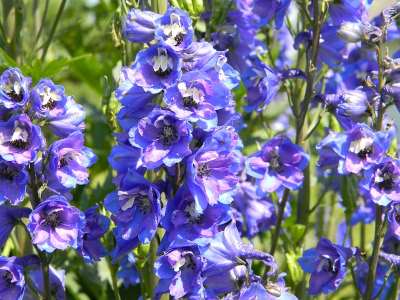
The delphinium, with its long cone-shaped purple and lilac blooms, has a long stem of purple flowers. The delphinium genus contains a wide range of blooming plants. Delphiniums are tall flowering perennial plants that may reach a height of 6.5 feet (2 meters) when fully bloomed! Growing delphiniums in your garden may be difficult. Full sun, but not very hot dry summer, is required for the tall perennials.
If there is a strong wind, they are also susceptible to breaking. The ‘Belladonna’ and ‘Elatum’ groups have some of the best purple delphiniums blooming. ‘Blue Bees,’ ‘Bruce,’ and ‘Blue Nile’ delphinium cultivars are good choices if you want to enhance your garden with stunning purple flowers. Between zones 3 and 8, delphiniums will generally thrive.
Lavender

Lavender is a popular and well-known purple perennial flowering herb that has fragrant purple blooms. The fragrant aromas of this drought tolerant plant are a delight in any garden, and its purple flowers are stunning. Despite the fact that there are several lavender cultivars, they all share a trait. Every year, this popular blooming herb produces a range of purple hues. Darker purple blooms are found in some cultivars, while lavender-colored blooms are found in others. Other gorgeous flowers have an virtually blackish purple color.
Lavender plants with purple blooming shoots may produce 8″ to 16″ (20 cm) long stems. Fields of lavender may appear to be a sea of purple when they are in full bloom since the flowering spikes are longer than the leaves. Plant lavender flowers in moist, well-drained soil in a location that receives continuous sunlight throughout the day.
Place lavender plants in the borders and beds in the middle or back positions. The healing essential oil of lavender, which helps you fall asleep better and heals wounds, is also well-known. From Zone 5 to Zone 9, the plants are hardy.
Millennium Flowering Allium
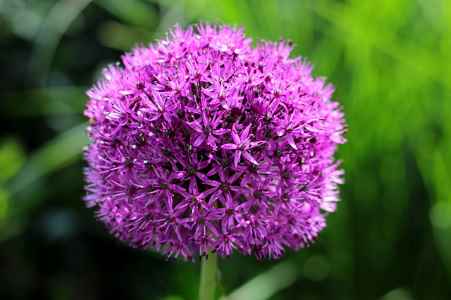
The fuzzy purple flowers of ornamental onions, such as the ‘Millenium Flowering Onion,’ ‘Round and Purple,’ or ‘Purple Pleasure,’ bloom into huge ball-shaped clusters. The bright hue of purple flowering onions attracts pollinators while adding a dose of color to any garden.
Because their blooms last a long time, flowering onions are especially suited for their purple colors. They’re also tough perennials that can tolerate temperatures as low as -20°F (-6°C). In a location that gets sunlight all day, cultivate decorative onions in the garden. These tall-growing evergreen plants, which may grow to be 4 feet (1.2 meters) high, will provide a vertical focus in the rear of flower beds and borders.
Coralbells

Some Coralbell (Heuchera) cultivars are a good option if you’re looking for a purple-leaf perennial. Types like Plum Pudding, Purple Palace, Purple Petticoats, and Dark Secret, for example, may provide stunning dark foliage to your garden landscape. Cora bells prefer a neutral to slightly acidic soil with good drainage and thrive in full sun to partial shade.
Plant them in clusters or along the front of beds and borders because they are low-growing perennial plants with a wonderful purple ground cover effect. Hardiness Zones: 4 to 9
